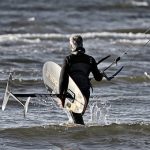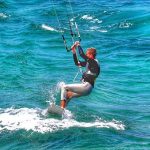Where To Fly?
Pick out a good, big, open field or beach to fly at. If you’re not sure where you can fly kites, check with your local council or kite school. Remember that if there are trees or buildings between you and the wind, the trainer kite will not fly properly.
You should be careful when flying your kite close to obstacles like trees, roads, and lamp posts, because the kite could become tangled in them. You should also avoid flying close to tall buildings, because the wind can have strange effects around them that can make the kite harder to fly. It’s like when a river flows over rocks and you see the eddies of water swirling around them. The same thing happens with the wind when it flows around buildings.
It is ideal to find a large open space if possible. It is important to stay away from areas with power lines. If you are unsure, consult the section on obstacle effects on wind speed for additional information on what to avoid.
The best spot to launch your kite is one where you have enough power to get it off the ground, but not too much wind that you get overwhelmed when it launches. This spot will change depending on how much wind you have.
What to Do Before You Arrive at the Beach?
Make sure to inspect your kitesurfing gear for any damage or wear and tear, even if you’re not at the beach.
Find a clearing that’s big enough to stretch your lines out fully. Then, walk through your lines as if you were getting ready for a session, untangling them as you go. I like to tie one end of all my lines to a solid object, and clip the other end to my leash using a carabiner. Walk back toward the kite, checking the lines for knots and fraying. If the lines are badly damaged, you should replace them.
After putting on your harness, check that the line is the right length and secure it to a fixed object. Then, lean back into the harness, putting gentle pressure on the lines.Now bring the bar in. The bar should be touching the top of the safety system. If it isn’t, this is a sign that your front lines have stretched and your kite will be prone to back-stalling.Also be sure that the kite is level in the air. To adjust the lines, first make sure that the bar is all the way in. Then, check to see if the bar is touching the top of the safety system. If it’s not, pull the bar in again and repeat this process until the lines are all the same length. If you’ve used all the knots on the bar, you may need to trim the lines on the kite. Also, be sure to check that the kite is level while it’s in the air.
It is advisable to examine the kite for any damage such as holes, and fix it as needed. I strongly suggest inflating the kite and leaving it for a period of time to make sure there are no leaks in the valve/bladder. The last thing you want is a kite that is in bad condition on your first session back!
The bridles on the kite can become worn out over time from the pulleys traveling along the lines constantly. Make sure to check them regularly and replace them as needed.
Kite Gear Care And Pre-Flight Checks
Ensure that:
- You have no knots in any of your lines
- You have no tangles or unwanted knots in the bridle
- Your kite and kite materials are in good condition, any small tears or holes need to be patched before flying the kite
- If you have any knots in your lines or bridle I would recommend you get them out before you start flying your kite. A knot in the line will reduce the strength of the line at that point by 50%, leading to a greatly increased chance of the line snapping while you are flying.
Take a piece of cloth and wrap it around the section of the line with the knot. Place the cloth containing the line and knot onto a hard surface, such as an old book. Take a hammer and start hitting the knot through the cloth, for about 20 seconds. Then, take another 20 seconds to try to pry the knot loose. Repeat this process until the knot works itself loose. Note that for the first few minutes, it may look as if nothing is happening. The key is patience; this does work, just give it a bit of time.
It’s important to make sure your kite is in good condition before flying it. If there are any ripped or torn areas in the canopy, don’t fly the kite and instead either patch it up or take it to get repaired. A small hole can quickly become a big one if it’s not dealt with right away. Also, check that the bridle is securely attached to the kite at all points. If you see the bridle coming away from the kite at any point, stop and take it to get fixed before flying it.
Setting up for Hot Launch
Light wind only
As you walk the kite towards you, hold the bar with your right hand and the kite lines in your left hand so when you get the kite over head, the right hand is controlling the kite and the left hand is feeding the lines out. Place your kite on the ground with the trailing edge into the wind. Weigh down the trailing edge with sand or another object. Unwind the lines from the bar as you walk into the wind. Hold the bar in your right hand and the kite lines in your left hand.
From The Edge Of The Wind Window (Recommended)
Put the kite down on the ground in a line with the wind, and fold it over so the bar is in the middle. Hold the kite down with something heavy, like sand or a rock, halfway along the kite, near the front edge. Then walk away from the kite at a right angle to the wind, holding the bar and lines.
Check that the lines are not tangled and un-ravel them if necessary. If you need to reattach the lines, use a larks head knot.
Hot Launch
Light Winds Only
To set up the kite, attach it to the bar and make sure it is directly downwind. Then, grab the center lines with one hand, keeping the other hand near the safety release. To launch, pull the center lines towards you. If the kite hasn’t been pre-inflated, it may flap around while it fills with air. Once it is fully inflated, it will be easier to control.
To launch a 2 line kite, simply pull on the bar.
Landing/Self-Landing
You should always land with an assistant if possible. If not, you can signal that you want to be landed by tapping your head, and then slowly lower the kite down.
If you have a great time kitesurfing and don’t realize that you’re the last one still out, it’s happened to me plenty of times.
To self-land the kite, pull the safety release.
When you are ready to launch, hold the kite at the wingtip and pull the safety. The kite will flag out behind you.
pull the bar toward you hand over hand along the safety line.
pull on the bar and follow the line through the bar, keeping only tension on the single safety line to prevent the kite from relaunching
As you walk towards the kite, grab the bridle that is connected to the safety line.
You can now hold the kite by the leading edge and store it normally.
R.O.W. Rules
1. Keep a proper lookout 2. Maintain a safe speed 3. Keep clear of other vessels 4. Use proper lights at night 5. Sound proper signals The most important rule of sailing is to avoid collisions, but there are some other rules that can help you avoid them. Here are my top five: 1. Pay attention to what’s happening around you. 2. Don’t go too fast. 3. Stay away from other boats. 4. Use the right lights at night. 5. Make sure you signal properly.
- Upwind kite Up, Downwind kite down (The golden rule).
- Starboard tack has the right of way over port tack. Starboard tack means you are going to the right with your right hand and right foot first.
- Give way to kitesurfers entering the water and trying to get away from the beach.
- The rider surfing a wave has priority, give way to them.
- No priority on land, please use common sense.
Know How to Perform a Self-Rescue
If you are an IKO member and have forgotten how to do a self-rescue, you can either book a lesson at an IKO-affiliated kite center, or watch a step-by-step video tutorial on the IKO website.
We should all practice this, especially now, so that we don’t overwhelm emergency services with unnecessary pressure.
Keep a Distance When on the Beach
It can be easy to forget to social distance when we’re at the beach and excited to see our kiteboarding friends, but please respect your country’s rules to help put the kiteboarding community in a good light.
Things to Remember
- You will crash your trainer kite! Try not to crash it directly downwind as it is possible to blow seams out of a kite if crashed directly into the ground at 50 miles per hour. Yes, they can move that fast.
- The wind is like a road; sometimes it’s bumpy and sometimes it’s smooth. Your kite may behave well one day and fly the next. Most likely the wind is very different, do not let this get you down and disheartened you, learning to fly a kite in ALL conditions is part of the training.
- Be careful in high winds. Even small trainer kites develop a lot of power. in general, a 3m trainer kite will allow a 200lb person to jump 6-10 feet forward when the winds are over 18mph. Always leave yourself room for evasive action (3-5 line lengths).
- If you have someone helping you launch the trainer kite, make sure they move immediately after launching. Also, be nice and share your kite with them.
- It takes most people anywhere from 30 mins to 3 hours to learn to fly a trainer kite proficiently. Don’t expect to be a great flier in 5 minutes.
- Twists in the lines – All kites will still fly the same even with a twist in their lines. To untwist the lines, either fly a complete loop in the other direction or spin your body quickly around. Most kites can fly with 2 or 3 loops before the lines begin to bind up.



